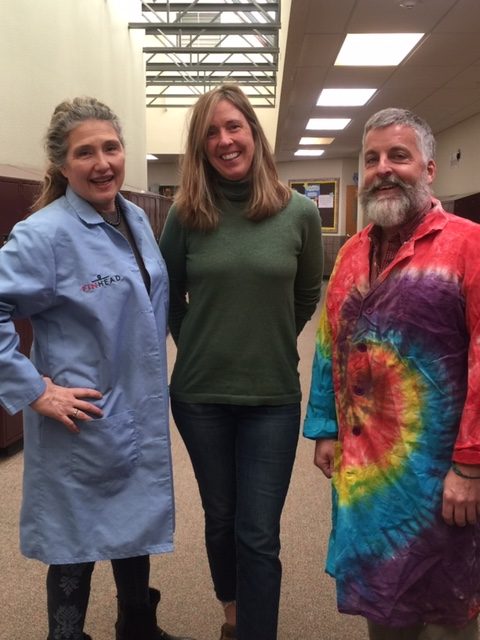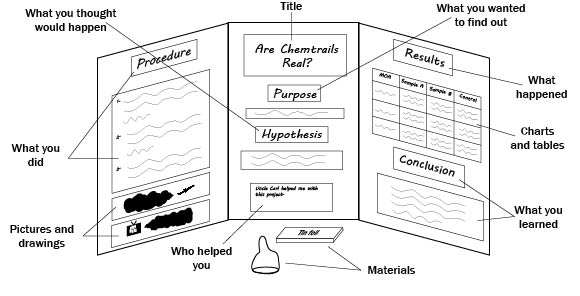
14 Jan Telluride’s 1st Ever Science Fair, Deadline to Enter, 1/23
All ages are welcome to compete for cash prizes in Telluride’s first ever Community Science Fair! Brought to you by Telluride’s Wilkinson Public Library, the Pinhead Institute, the Telluride Education Foundation, the Ah Haa School for the Arts, and Telluride Intermediate School sixth grade teacher Colin Hubbard. Bring your STEAM, Rube Goldberg, or traditional science fair project to the library at 4 p.m. on Saturday, January 26 to set up. Doors open at 5 p.m. for the public to see what their friends and neighbors have been cooking up. Please email Tiffany Osborne here by January 23 to let her know you will be participating. Did we mention CASH PRIZES?

Left to right: Sarah Holbrooke, Pinhead Institute; Tiffany Osborne, Wilkinson Public Library,; Colin Hubbard, Science Teacher, Telluride Intermediate School. Not pictured, Tara Carter, Ah Haa.
If you attended Mountainfilm 2018, you likely know the story of “Science Fair,” a festival favorite.
According to Rotten Tomatoes, “Science Fair” was hailed by critics as “immensely likeable,” “brilliant and quirky” and an “ode to the teenage science geeks on who our future depends.”
The doc follows nine high school students from around the globe as they navigate rivalries, setbacks and, of course, hormones, on their journey to compete at The International Science and Engineering Fair. As 1,700 of the smartest, quirkiest teens from 78 different countries face off, only one will be named “Best in Fair.”
The film offers a front tow seat to the victories, defeats and motivations of an incredible group of young men and women on a path to change their lives – and the world – through science.
Will the next “Best in Fair” come from Telluride?
Find out on January 26, when Telluride’s Wilkinson Public Library, Pinhead Institute, the Telluride Education Foundation, Ah Haa and TIS’s Colin Hubbard host Telluride’s first ever Community Science Fair.
The latest happening on Telluride’s cultural calendar is the brainchild of the library’s Tiffany Osborne.
“I was at a library conference representing Telluride and Isabelle Hawkins was the keynote speaker. Mrs.Hawkins is an PhD astronomer with the Exploratorium in San Francisco. During her speech, she kept referring to the importance of science in communities, and cultures and for the ages. Science is about facts and in these challenging times, facts are important – and can be lots of fun. What’s more, science does not discriminate. During the lecture, I texted the Program Director at our library, Elissa Dickson, and asked if we could host a Community Science Fair. Elissa said ‘absolutely, sounds amazing.’ But then to truly be a community event, we needed to enlist other key players to participate. It seemed like a natural fit to reach out to Sarah Holbrooke of Pinhead. Colin Hubbard has always held the sixth grade Science Fair at the Telluride Intermediate School and every kid remembers and enjoys this part of the school year, that is the idea of creating and executing a science project. Tara Carter from Ah Haa was more than willing to come on board, because, well, art and science go hand in hand.”
Osborne & CO.’s Really Big Idea is to bring people of all ages together – teams, families, groups whatever and whoever it takes – to create and explore what amazing discoveries Telluride might be capable of producing.
Stay tuned…
Double, double toil and trouble….
Community Science Fair, key details:
The Science Fair Committee reserves the right to disallow a demonstration they feel comprises the safety of people or property.
There are three options for entries – Technology Project; Science Experimental Project; or Creative STEAM Project. See below for details about each.
Technology Project (Rube Goldberg Competition)
The technology project consists of building a Rube Goldberg Machine for a showcase. If you enjoy making things and want a chance to learn more about simple machine physics as you design and build an imaginative and fun contraption. Remember, this contest is about your creativity and resourcefulness as well as your understanding of simple machines.
Examples: Put toothpaste on toothbrush; turn the page of a book; turn a switch on/off
The contraption must complete the assigned task in the prescribed number of total steps (or more) and include a minimum of at least three “simple machines” which are: 1.Incline, 2. Wedge, 3. Screw, 4. Lever, 5. Axel and Wheel, 6. Pulley.
1. Pretty much anything goes, the only restrictions are that no flammable or toxic substances or animals (dead or alive) may be used. Maximum voltage is 12V.
2. Must have copies of a clear and concise step-by-step description of the machine.
3. The machine must complete a full cycle, be reset and complete a second full cycle.
4. Size limited to 4’x6’x6’.
5. Must include a sketch/drawing or description of what the project is supposed to be
Winners will be chosen at judges discretion and People’s Choice.
Science Experimental Project (Life or Physical)
A science experimental project is an investigation that explores how the world works using the scientific method. Have you ever wondered what bugs fly the fastest, what soil makes the reddest radishes, or how video games might dull pain? If so, an experimental project is for you.


Projects are placed and judged in one of the following categories:
1. Life Science: Plants, Animals, Human or Animal Behavior, etc.
2. Physical/Earth Science: Chemistry, Physics, Geology, Astronomy, Computer Science, Mathematics etc.
Remember, this is more of a “traditional” science fair project. It involves doing actual research into a question. Investigations that involve observations and data gathering but not experimentation are also appropriate.
Projects may be up to 36” wide and no taller than 48”. It must be able to stand on the table by itself.
Projects from this category will be judged on this rubric.
Creative STEAM (Science, Technology, Engineering, Art and Math) Project
These projects bring together many areas of study in a project of your choice that is more flexible. Do you like coding, building models, or communicating complex information? Then STEAM is for you!
A STEAM project can involve things like identifying and solving design problem, creating a piece of software that meets a social need, or communicating complex information in a creative memorable way.
Criteria:
1. Purpose-Is there a clear purpose to the project and is it communicated in a clear manner
2. Integration– Combine multiple areas -this is STEAM
3. Content Mastery– The project demonstrates clear understanding of the concepts presented and articulated well
4. Exhibition-The project is exhibited in a clear and detailed way to ensure viewers have a clear understanding of all aspects of the project.


Sorry, the comment form is closed at this time.